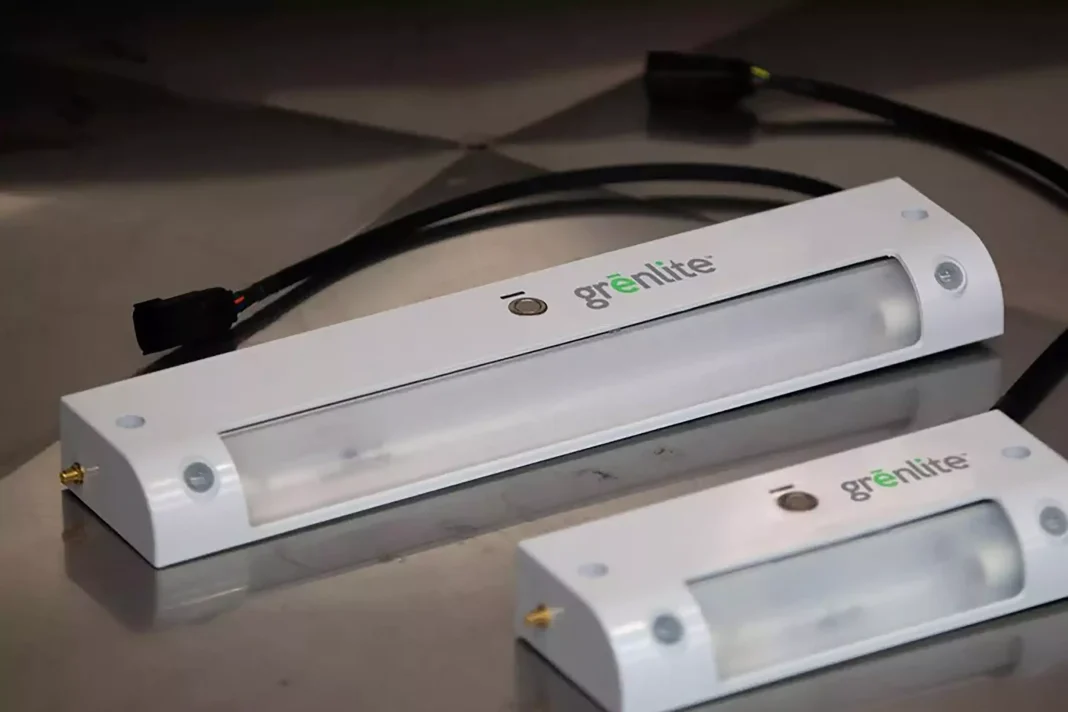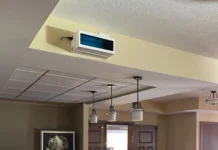Esai Umenei, Ph.D., principal engineer-innovation, GHSP
The COVID-19 pandemic has affected all of America and the world, stretching medical and ambulance services to the limit. Previous studies and surveys in the emergency services industry have indicated that a large percentage of EMTs feel they are exposed to injury and disease risk on a constant basis.1 The pandemic has only increased these associated risks for EMTs, commercial and transit service workers whose jobs are essential and cannot be suspended or done remotely.
UV-C technology has been shown as being effective at mitigating the coronavirus in air and on surfaces, along with many other pathogens and disease-causing microbes.2 There are many UV-C devices on the market with different claims. However, many have inherent limitations for use within emergency and commercial vehicles, including functionality (they do not deliver the proper dosages to kill the pathogens present), use case (they require downtime and constant stopping of workflow due to either their size or their mode of operation) and disinfection uniformity (different EMT teams implement enhanced safety protocols differently, and non-intelligent deployment of UV-C means uneven disinfection within the cabin).3-5 While information about the use of ultraviolet germicidal irradiation (UVGI) in hospital rooms is limited, information about the use of UVGI in ambulances is virtually nonexistent.
Two trial studies were carried out with two emergency service providers from West Michigan, the purpose being to assess the efficacy of the grēnlite™ UV-C system and compare said efficacy before and during the COVID-19 pandemic.
The grēnlite™ system is a modular system of smart UV-C sources (ESP400, ESP200) working together through a control module to disinfect vehicles by intelligently monitoring and disinfecting high-touch surfaces when it is safe to do so with minimal interruption to the EMS and commercial vehicle drivers.
Manual and automatic options ensure that EMTs have options that fit their work cycles. An additional cloud module provides the ability for over-the-air updates (maintenance, change of dosage in case of new pathogen of interest or pandemic, etc.) along with disinfection and operations data capture and storage for use by the fleet owners and managers.
Protocol and data collection
Twelve in-service vehicles from two EMS service organizations were used with six of the vehicles installed with the grēnlite™. The studies were carried out six months apart, one pre-COVID-19 and the other mid-COVID-19. Six other vehicles were used as a control.
Protocol called for the systems to be installed but not turned on and the vehicles to return to service for at least a week with the EMTs performing their typical cleaning protocols (pre-COVID-19) and the emergency cleaning protocols (ECPs) used during COVID-19. After a week of operation, the systems were turned on (only operated when it was deemed safe and not interrupting ongoing work within the ambulance cabin) for three days. Rodac plates with TSA and tween/lecithin were used for surface bacterial sampling.
The air bacterial and fungal air samples were collected using a dual head SAS 180 air sampler on media plates with TSA and 5% blood. The unit pulled 1,000 liters of air. Samples were collected from all 12 vehicles from a selection of 10 high-touch and high-risk surface zones identified using field interviews and industry standard publications.6, 7
More than 160 sample plates with TSA and tween/lecithin were used for surface sampling. After sample collection, they were shipped in a temperature-controlled, overnight shipping container to a third-party lab – EMSL – for processing. Interviews also were conducted with the ambulance EMTs before and after the system was installed.
Results and discussion
Results of the study were reported in total colony-forming units (CFUs) per location sampled per vehicle. These were then analyzed as average CFUs per location across installed vs. non-installed vehicles. EMS disinfection was quantified as a function of total bacterial contamination in average CFUs.
The average CFU count from four ambulances pre-COVID-19 was measured at 250 CFUs, compared with mid-COVID-19 average of 27 CFUs. Despite a small sample size, the results of the test seemed to support the idea that EMS vehicles were considerably less contaminated when the ECPs were put in place, although these protocols added more time and work for EMTs during their shifts.
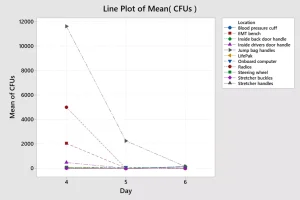
Figure 1 shows the pre-COVID-19 trial showed more than 90% reduction across all surfaces. There also was a significant cumulative effect of UV-C use as the general bio-load across all vehicles and surfaces was reduced on every subsequent use of the UV-C system. This indicated that such a system could not only achieve disinfection within these vehicles but could maintain it at such levels consistently, while minimizing transmission risk to EMTs and transport patients alike. It also suggested that the UV-C system, in complement with the typical cleaning protocols, was just as good as the ECPs put in place during the pandemic, without any commensurate increase in workload or resource use.
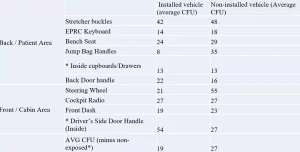
Table 1 shows the breakdown of average CFUs per surface sampled across all the ambulances in the study. There was an average 42% drop in bacterial contamination of the surfaces that were exposed to UV-C light as compared to those that were not. Due to shadowing or cabinet windows that were closed, not all surfaces got UV-C irradiance, and these surfaces (inside cabinet, door handle grooves) did not see any reduction in CFU counts, while the exposed surfaces did. This percentage is remarkable because the UV-C disinfection effects were still impactful after the ECPs were in use.
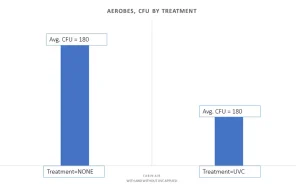
Another important result of the study, as shown in Figure 2, was the realization that the grēnlite™ system, though implemented to target high-touch surfaces, had the bonus effect of disinfecting the air in the ambulances by an average of 5%. This was despite the constant opening of doors/windows and limited air movement. It indicated that this UV-C system could be effective for air disinfection within these vehicles with increased air movement.
Conclusion
In a literature review, little data was available to support the hypothesis that UV-C systems installed within EMS vehicles mid-COVID-19 and its ECPs were of any help, nor was there much in terms of EMT feedback on how these systems helped them. The grēnlite™ trials confirm the efficacy of UV-C technology as a viable supplementary technology for EMS and other commercial vehicles. It also indicated high technology adoption and approval within the users in this study when this technology is appropriately implemented within their specific use case.
Contact: Esai Umenei, umeneie@ghsp.com
References
- https://www.emsworld.com/article/10323499/naemt-four-five-medics-injured-job
- Adel Haji Malayeri et al. ‘UV Dose Required to Achieve Incremental Log Inactivation of Bacteria, Protozoa and Viruses’, https://www.iuva.org/Guidance-Documents
- William G. Lindsley et al.,’Ambulance disinfection using Ultraviolet Germicidal Irradiation (UVGI): Effects of Fixture Location and Surface Reflectivity’, J Occup Environ Hyg. 2018 January; 15(1): 1–12. doi:10.1080/15459624.2017.1376067
- IAB: “2012 The InterAgency Board (IAB) R&D Priority List descriptions. https://iab.gov/Uploads/2012-S%26T-R%26D-Priority-List-Descriptions.pdf
- Anderson, D.J., L.F. Chen, D.J. Weber et al.,’Enhanced terminal room disinfection and acquisition and infection caused by multidrug-resistant organisms and Clostridium difficile (the Benefits of Enhanced Terminal Room Disinfection study): a cluster-randomised, multicentre, crossover study’, Lancet 389(10071): 805-814 (2017).
- PIDAC- 2009.
- Noh H. et al. Bacterial Contamination in Ambulances, Valdez et al.


